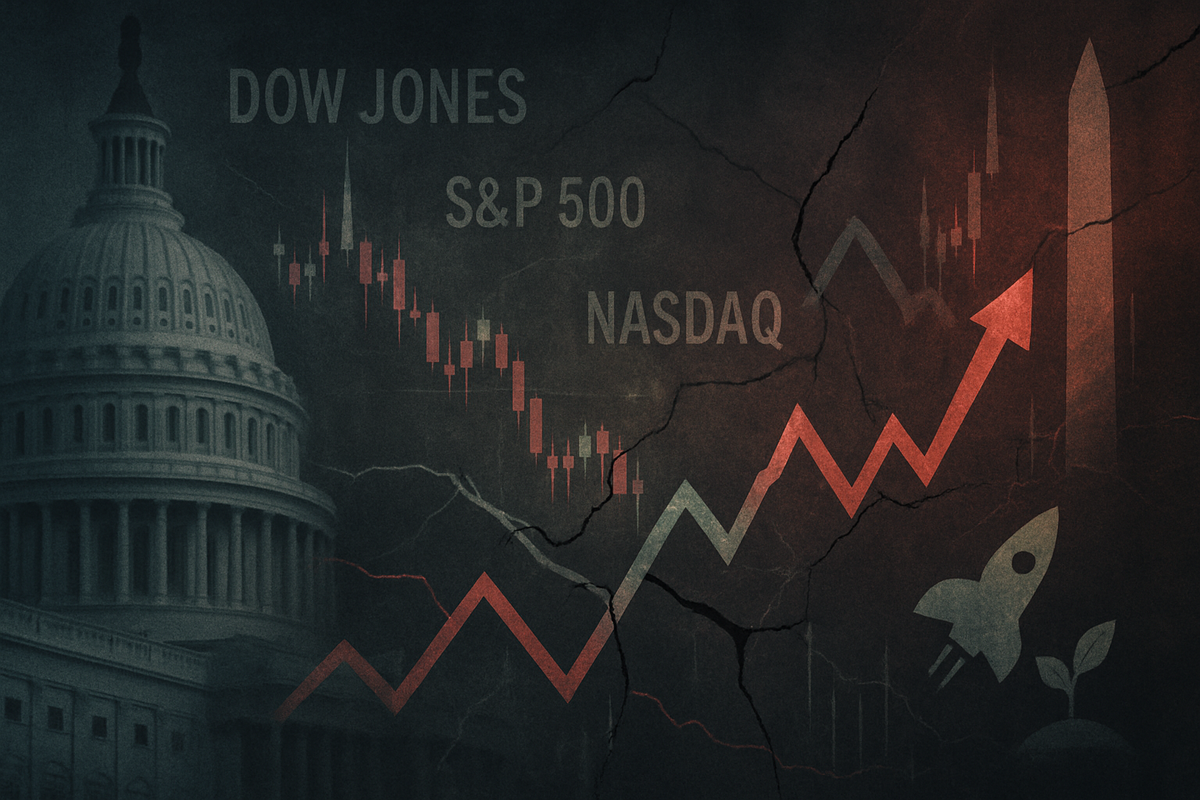
The prospect of a U.S. government shutdown, or the reality of a recent one, consistently casts a shadow of uncertainty over financial markets. While often viewed as a political impasse, its economic ramifications are tangible, immediately impacting major indices like the Dow Jones Industrial Average (NYSE: DJIA), S&P 500 (NYSEARCA: SPY), and Nasdaq Composite (NASDAQ: IXIC), and posing a particular threat to the fragile recovery of the Initial Public Offering (IPO) market. As of October 7, 2025, the market is absorbing the implications of such fiscal disruptions, highlighting the delicate balance between political gridlock and economic stability.
The immediate implications typically involve increased market volatility and a cautious retreat by investors. Although historical data suggests that the overall impact on broader indices is often temporary and muted, the halting of non-essential government functions creates ripples that can affect various sectors and investor confidence, forcing a re-evaluation of strategies and outlooks in the short term.
The Recurring Impasse: A Look at Past Shutdowns and Their Market Echoes
Government shutdowns are a recurring, albeit uniquely American, feature of the nation's political landscape, arising from a failure by Congress and the President to agree on funding legislation. When annual appropriation bills or temporary continuing resolutions are not passed by the fiscal year deadline, non-essential federal agencies cease operations, leading to furloughs for hundreds of thousands of federal employees and a suspension of numerous government services. While essential services like air traffic control and law enforcement continue, employees often work without immediate pay, creating widespread economic and social disruption.
Historically, the U.S. has experienced several significant shutdowns. Notable examples include the two shutdowns in 1995-1996 under President Bill Clinton, which lasted a combined 26 days due to disputes over federal spending. The 2013 shutdown, a 16-day impasse during President Barack Obama's administration, stemmed from disagreements over the Affordable Care Act (ACA), leading to an estimated $24 billion in lost economic output and delays in critical economic data releases. Most recently, the 2018-2019 shutdown, the longest in U.S. history at 35 days under President Donald Trump, was triggered by demands for border wall funding, costing the American economy at least $11 billion and causing significant disruptions across nine executive departments.
During these events, key governmental agencies such as the Securities and Exchange Commission (SEC), Food and Drug Administration (FDA), Environmental Protection Agency (EPA), and various bureaus responsible for economic data (e.g., Bureau of Labor Statistics, Bureau of Economic Analysis) operate with minimal staff or cease non-essential activities. This directly impacts regulatory approvals, data dissemination, and public services. The initial market reactions, while often volatile, have historically shown a tendency for major indices like the S&P 500 (NYSEARCA: SPY) to exhibit mixed performance, sometimes even posting gains during the shutdown period itself, as investors often "look through the noise" of political disputes to underlying economic fundamentals. However, the uncertainty created by the lack of economic data can still complicate investment decisions and Federal Reserve policy.
Corporate Fortunes: Winners and Losers in a Shutdown Scenario
A government shutdown creates a distinct bifurcation among public companies, with some facing significant headwinds and others proving remarkably resilient. Companies with substantial reliance on federal contracts, regulatory approvals, or government services are typically the most vulnerable. This includes major defense contractors like Lockheed Martin (NYSE: LMT) and Boeing (NYSE: BA), as well as IT service providers such as Oracle (NYSE: ORCL) and Microsoft (NASDAQ: MSFT) with federal contracts, which can experience immediate stop-work orders, project halts, and delayed payments, impacting cash flow and operations. Smaller subcontractors are particularly susceptible to financial strain and workforce disruptions.
Heavily regulated industries also bear a considerable burden. Companies planning Initial Public Offerings (IPOs) are severely affected, as the Securities and Exchange Commission (SEC) largely ceases non-essential operations, stalling crucial approvals and potentially delaying market debuts. Similarly, biotech firms awaiting Food and Drug Administration (FDA) approvals for new drugs or medical devices, energy companies needing Environmental Protection Agency (EPA) permits, and technology companies requiring Federal Communications Commission (FCC) licenses face costly delays that can postpone strategic transactions and product launches. The tourism and hospitality sector also suffers from the closure of national parks and potential disruptions to air travel due to understaffed federal agencies.
Conversely, companies with minimal government exposure or those in defensive sectors tend to fare better. Businesses whose revenue streams are primarily derived from the private sector or international markets, such as general consumer goods companies or certain global technology firms, are more insulated from domestic political impasses. Defensive sectors like utilities, consumer staples, and specific healthcare providers (particularly those not heavily reliant on new drug approvals or discretionary government programs, as mandatory programs like Medicare and Medicaid typically continue) often outperform during periods of market uncertainty, providing essential goods and services regardless of the political climate. Alternative investments like gold (COMEX: GC=F) and even short-dated U.S. Treasuries (due to safe-haven demand) can also attract investors seeking stability during these turbulent times.
Broader Implications: Beyond the Immediate Market Shock
The wider significance of a U.S. government shutdown extends far beyond immediate financial market fluctuations, embedding itself within broader economic trends and casting ripples across global industries. Each week of a shutdown can shave an estimated 0.1% to 0.2% off quarterly Gross Domestic Product (GDP) growth, with some economic losses, particularly in service industries, becoming permanent. This economic drag, when superimposed on existing challenges such as global inflation, slowing growth, or a weakening job market, can exacerbate vulnerabilities and make the overall economic environment more precarious. The suspension of critical economic data releases from agencies like the Bureau of Labor Statistics and Bureau of Economic Analysis creates a "data blind spot," complicating decision-making for investors, businesses, and the Federal Reserve, thereby increasing overall market uncertainty.
The ripple effects of a shutdown are not confined to domestic borders. Global supply chains can experience significant disruptions as understaffed customs agents slow import documentation, leading to delays at major ports and increased freight costs for both U.S. and international businesses. International markets become jittery, and while the U.S. dollar (USD) often benefits from its safe-haven status, prolonged shutdowns can subtly erode international confidence in America's political stability and fiscal management, potentially encouraging diversification away from U.S. assets. Exporters and importers globally rely on U.S. agencies for regulatory reviews and trade compliance, and delays in these functions can lead to lost market access or increased operational costs for international partners.
From a regulatory and policy perspective, a shutdown creates significant bottlenecks. Agencies like the Securities and Exchange Commission (SEC), Food and Drug Administration (FDA), and Environmental Protection Agency (EPA) operate with minimal staff, delaying critical approvals for Initial Public Offerings (IPOs), drug trials, environmental permits, and mergers. This regulatory paralysis can stall innovation, postpone strategic corporate actions, and create a backlog that takes weeks or months to clear even after the government reopens. Furthermore, the very occurrence of a shutdown underscores deep political disagreements over budget priorities and broader ideological conflicts, effectively halting new policy initiatives and regulatory changes until a resolution is found, highlighting a unique aspect of American governance often not seen in other advanced economies.
The Path Forward: Adapting to Uncertainty
In the short term following a government shutdown, the U.S. stock market typically navigates an initial period of heightened volatility before generally finding its footing. Historical patterns suggest that while immediate jitters are common, especially for government-dependent sectors, the broader market tends to recover relatively quickly once the funding impasse is resolved. Investors should anticipate a gradual return to focus on fundamental economic drivers such as corporate earnings, inflation trends, and the Federal Reserve's monetary policy decisions, particularly regarding interest rates, which are critical in the current economic climate as of October 7, 2025.
For businesses, strategic pivots become essential. Government contractors must prioritize diversifying their revenue streams and establishing robust contingency plans to mitigate the impact of delayed payments and project suspensions. Companies in heavily regulated sectors, from biotech to finance, need to factor in potential regulatory delays into their timelines for product launches, mergers, and capital-raising activities, potentially requiring adjustments to operational strategies or even seeking alternative markets for growth. Prudent cash flow management is paramount across all sectors, as indirect effects can still create liquidity challenges.
Looking long-term, while individual shutdowns have historically had a limited lasting impact on overall equity performance, a pattern of recurring fiscal brinkmanship could subtly erode investor confidence in U.S. governance, potentially influencing capital allocation decisions over time. Emerging market opportunities or challenges may arise, as global investors might seek more stable or growth-oriented alternatives if U.S. political instability persists. Investors should remain diversified, consider safe-haven assets like gold (COMEX: GC=F) as a hedge against uncertainty, and maintain a long-term perspective. The key will be to differentiate between temporary political "noise" and fundamental shifts in economic or corporate health.
Investor Outlook: Navigating the Post-Shutdown Landscape
The recent U.S. government shutdown, like its predecessors, serves as a stark reminder of the interplay between political decisions and financial market stability. While it introduced immediate uncertainty and volatility, particularly impacting sectors reliant on federal funding and regulatory approvals, historical evidence consistently points to a market that is largely resilient, often recovering its footing and returning to focus on core economic fundamentals once the political impasse is resolved. The economic drag, though real, tends to be temporary, with much of the lost activity recouped post-reopening.
Moving forward, the market's trajectory will primarily be dictated by factors beyond the shutdown itself: the Federal Reserve's interest rate policy, the trajectory of corporate earnings, and broader macroeconomic indicators. The resumption of delayed economic data releases will be crucial in providing clarity for both policymakers and investors. While the immediate aftermath may see some lingering caution, the underlying strength of the U.S. economy and the adaptive capacity of its businesses typically allow for a relatively swift rebound.
The lasting significance of individual shutdowns on the overall market is generally minimal, often perceived as political theater rather than a fundamental economic crisis. However, a recurring pattern of such events could subtly erode confidence in U.S. fiscal management over the long term. Investors should, therefore, maintain a disciplined, diversified approach, avoiding knee-jerk reactions to political headlines. In the coming months, watch closely for the Federal Reserve's next moves, the strength of corporate earnings reports, and the overall health of the labor market, as these will be the true determinants of market performance, far outweighing the transient impact of governmental funding disputes.
This content is intended for informational purposes only and is not financial advice.





